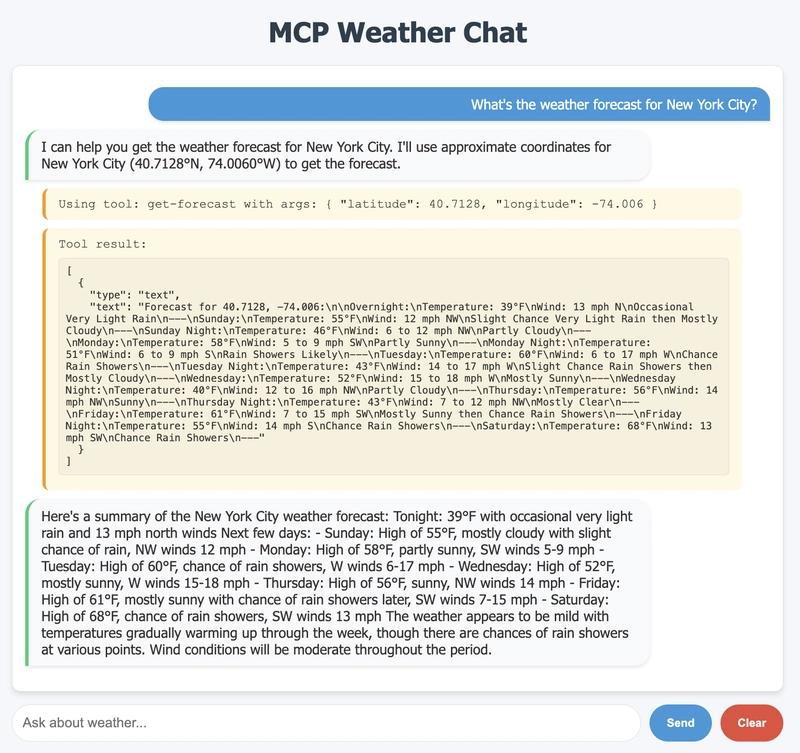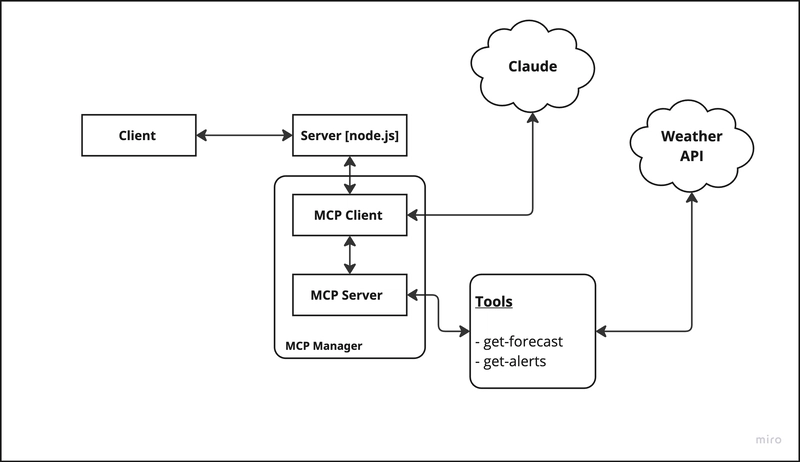Building a Chat App with MCP(Model Context Protocol) in Node.js
I recently built a simple chat application that lets Claude call external tools using the Model Context Protocol (MCP). Here's how you can build one too.
What is MCP?
The Model Context Protocol (MCP) is a standardized way for AI models like Claude to interact with external tools. It provides a structured format for:
- Defining tools the AI can use
- Sending requests from the AI to tools
- Returning results back to the AI
Project Structure
The application has three main parts:
-
Express Server (
server.js): Handles web requests and user sessions -
MCP Client (
mcpClient.js): Connects to Claude and the MCP server -
MCP Server (
mcpServer.js): Defines and implements the tools
Chat UI
Architecture
How to Add Tools to Your MCP Server
The MCP server is where you define tools that Claude can use. Here's a basic example of how to create a weather tool:
// In mcpServer.js
import { Server } from "@modelcontextprotocol/sdk/server/index.js";
const server = new Server({ name: "mcp-weather-server", version: "1.0.0" });
// Define a weather tool
server.defineTool({
name: "getCurrentWeather",
description: "Get the current weather for a location",
inputSchema: {
type: "object",
properties: {
location: {
type: "string",
description: "The city and state, e.g. San Francisco, CA",
},
unit: {
type: "string",
enum: ["celsius", "fahrenheit"],
description: "The unit of temperature to use",
},
},
required: ["location"],
},
handler: async function (args) {
const { location, unit = "celsius" } = args;
// Here you would typically call a weather API
// For demo purposes, we're returning mock data
return {
location: location,
temperature: unit === "celsius" ? 22 : 72,
conditions: "Sunny",
humidity: "45%",
windSpeed: "10 km/h",
};
},
});
// Start the server
server.start();
Available Tool Types
You can create different types of tools for Claude to use:
- Data Retrieval Tools: Get weather, news, stock prices, etc.
- Calculation Tools: Perform complex calculations or data analysis
- Database Tools: Query or update databases
- API Integration Tools: Connect to external services
- File Processing Tools: Read, write, or analyze files
How the MCP Client Works
The MCP client connects Claude to your tools:
async processQuery(query) {
// Add user message to history
this.chatHistory.push({ role: 'user', content: query });
// Send to Claude with tool definitions
const response = await this.anthropic.messages.create({
model: "claude-3-5-sonnet-20241022",
max_tokens: 1000,
messages: this.chatHistory,
tools: this.tools,
});
// Process the response
for (const content of response.content) {
if (content.type === "tool_use") {
// Claude wants to use a tool
const result = await this.mcp.callTool({
name: content.name,
arguments: content.input,
});
// Send tool result back to Claude
this.chatHistory.push({
role: "user",
content: JSON.stringify(result.content),
});
}
}
}
Setting Up Your Project
To build your own MCP chat app:
- Clone the repository:
git clone https://github.com/RajeshRenato/mcp-node - Install dependencies:
npm install - Add your Anthropic API key to a
.envfile - Create your tools in
mcpServer.js - Start the server:
node server.js
Example Tools You Can Build
Here are some ideas for tools you could add:
- News Search: Fetch recent news articles on a topic
- Wikipedia Lookup: Search and summarize Wikipedia content
- Calendar Integration: Check or create calendar events
- Language Translation: Translate text between languages
- Image Generation: Generate images based on text descriptions (using DALL-E or similar)
Conclusion
The Model Context Protocol opens up exciting possibilities for AI applications. By giving Claude access to external tools, you can build powerful, interactive applications that combine AI with real-time data and functionality.
Want to try it yourself? Get the complete code on GitHub.
Got questions? Drop them below! 🚀





Top comments (2)
Impressive work! How can this framework improve user interactions in real-world applications?
Thanks for the kind words!
Model Context Protocol improves real-world interactions with real-time data, personalized responses, reduced hallucinations, complex workflows, and domain-specific insights.
In my tests and personal use cases, I saw a big boost in accuracy—like getting exact weather info instead of guesses.
Happy to explore how it can fit your needs too!